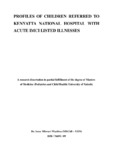| dc.description.abstract | Referral is a crucial component of primary health care, and when used well, it's been shown to markedly improve the outcome of illnesses in children.
Integrated Management of Childhood Illness (IMCI) is a strategy that was introduced in Kenya in 1999. Key to this strategy is the timely and appropriate identification and treatment of severely ill children, which often requires referral to higher levels of care. Kenyatta National Hospital, a tertiary referral hospital situated in Nairobi, is at the apex of this system in Kenya; however it continues to serve as a primary health care center.
Objective
To document the pattern of diagnoses among less than 5 yr old children with IMCI listed acute illnesses referred to Kenyatta National Hospital.
Design
Hospital based cross sectional study.
Setting
Pediatric Emergency Unit and pediatric wards at the Kenyatta National Hospital.
Methods
A total of 147 caretakers and their ill children were enrolled randomly into the study between July and August 2011 by consecutive sampling. Questionnaires were then administered to the guardians. Questions asked on clinical profile included socio-demographic e.g. child's age, sex, the guardian's relationship to the child, the guardian'S level of education and occupation, child's presenting complaints and the diagnoses among less than 5 yr old children with IMCI listed acute illnesses referred to Kenyatta National Hospital, the duration between referral and arrival to Kenyatta National Hospital, why these children were referred and the health facilities referring children to KNH.
Results
Of all the caretakers interviewed 93% were mothers, 1% were fathers, the rest were relatives. 57% of all the ill children were boys. Eighty four percent (84%) of the all the referred children presented with fever and 65% presented with fast or difficult breathing or a cough. Forty one percent (41%) of acutely ill children presented with pneumonia. The next most common diagnosis was diarrhea and dehydration (19%) followed by anemia inlO% of referrals. The median duration between referral and arrival at KNH was 48 hours, though it ranged from one hour to three weeks. Majority of patients made it within 24 hours, however those who didn't cited the following reasons: lack oftransport (7%), need to consult spouse (4%) and lack of knowledge about the seriousness of the condition by the care givers (3%).Patients whose caretakers were advised to go to KNH immediately were more likely to complete referral within the first 24 hours (40%) compared to those who were not advised on when to complete the referral (19%). Lack of necessary equipment in the referring centers was the main reason for referral of patients to KNH, as reported by 84% caretakers. This was followed by shortage of staff (16%), inability to afford treatment (10%) and shortage of drugs (6%).
Most referrals of children with IMCI listed acute illnesses were mainly from private facilities (52%). This was followed by health centers (18%) then district hospitals (15%). Eighty one percent (81 %) of the caretakers reported that they had been issued with referral notes, 10% of them were not given referral notes. 63% of the patients whose caretakers reported that they had a note had adequate information while only 34%ofnotes had useful information.
CONCLUSION
Pneumonia was the most common diagnosis followed by diarrhea and dehydration then anemia. While most referrals were within 24 hours, some took as long as three weeks to arrive in hospital. Lack of transport was cited as a reason for delays in referral. Inadequate equipment was cited as the most common reason for referral from public facilities. However, some caretakers didn't know why their children were referred. Private clinics and hospitals formed the largest percentage of facilities that referred children to hospital, the main reason being due to lack of affordability. Children with acute IMCI listed illnesses are still being referred from provincial and district hospitals. Some children had been referred without referral notes. Not all referral notes were adequate.
RECOMMENDATION
The appropriateness of referrals to KNH could be improved by standardizing referral procedures so that children should not be referred directly from primary to tertiary facilities. The government needs to equip intermediate level facilities by employing more staff and supplying necessary equipment and drugs. This will go a long way in reducing the number of referred children with acute illnesses to KNH. Care takers need education on importance of referring their children to hospital the soonest possible. Clinicians need to advice caretakers on need to refer children immediately. It is important to emphasize to clinicians the need of referring patients with comprehensive referral notes. | en_US |

